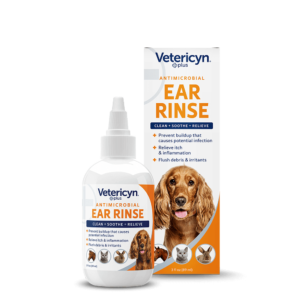Updated Aug 27, 2025
Your beloved cat is scratching and pawing at their ears nonstop, shaking their head, and rubbing their ears on the carpet. Maybe you’ve even seen nasty brown debris inside of their ear canal or noticed an unpleasant smell.
What can you do to help your cat feel better and get back to playing with their toys and chasing the laser pointer instead of itching their ears all day?
Although rare, ear infections may occur in cats and the first step to managing a feline ear infection is identifying the problem (usually in consultation with your veterinarian). In this short guide, we’ll cover what to expect from your vet visit, how to administer ear medication, and the steps you can take to prevent them.
Preparing for your Vet Visit
First things first: if your cat is scratching their ears or falling off-balance, it’s important to investigate the issue rather than chalking it up to the cat crazies. Likewise, any change in their ear appearance or odor—from black discharge to redness and beyond—needs a specific diagnosis as they are common cat ear infection symptoms.1
Not every cat enjoys a trip to the vet. So what can you expect when taking your kitty in for an ear exam?
- Your cat’s veterinarian will examine your pet’s ear canal to determine the health of the eardrum. They will also look for tumors or foreign material lodged inside the ear canal.
- They will take a sample by swabbing the ear, and it will be examined under a microscope to find out if bacteria, yeast, or ear mites are part of the problem.
- If the infection is severe or there’s a great deal of inflammation, discharge, and debris, an examination might not be possible without sedation or anesthesia.2
Once the examination and testing are concluded, the veterinarian will prescribe appropriate treatment, which may include:
- Antibiotics
- Anti-parasitics
- Antifungals
- Corticosteroids
- Medicated ear cleaner or ear flush
In some cases, adding an at-home product like Vetericyn Triple Action Ear Treatment can help provide itch relief, remove infection-causing buildup, and support ear health alongside your veterinarian’s recommended care.
Your veterinarian will direct further treatment if the infection is secondary to another problem.
How to Apply Medication to Your Cat’s Ears
Some kitties will tolerate the administration of ear drops better than others.
Ear infections are painful, and even the gentlest, calmest cat could respond by scratching or biting while you’re touching their ears. Nonetheless, it’s important to follow the vet’s instructions carefully.
Use the following guidelines to apply medication with minimal distress to you and your cat3:
- Carefully read the instructions on the medication’s label provided by your veterinarian.
- Wrap your cat securely in a blanket or towel with only their head exposed (not all cats will need this step).
- Hold your cat securely in your lap.
- Roll the bottle between your palms to warm the medication, then draw the liquid into the dropper, and hold open your cat’s ear canal.
- Apply the dose slowly into the inner ear, but don’t touch the applicator to the ear.
- Gently and calmly massage the base of your cat’s ear in a circular motion.
- Release the ear and allow your cat to shake their head.
- Wipe any debris or discharge from the outer ear with a cotton ball and throw the cotton ball away.
- Reward good behavior with affection and a treat (if your cat is into that!).
Preventing Ear Infections
As always, the best medicine is prevention.
There are numerous potential causes of a cat ear infection, including:
- Microbes – While yeast and bacteria are a natural part of the skin microbiome, excess yeast and bacteria can build up over time. Mites, highly contagious between cats, cause roughly half of all cat ear infections.1
- Excessive earwax – Wax can build up in the canal, often exacerbating microbial issues.
- Other health issues – If mites aren’t the problem, most cat ear infections are secondary to another problem, such as allergies, a mass or foreign body in the ear canal,or systemic disease.1 When your kitty’s immune system is weakened by disease or allergies, they’re less able to fight off potential pathogens that affect the ear.
- Moisture – When a cat attempts to drink from the tap, they may tilt their head sideways and get wet. Likewise, licks from other cats can introduce moisture into the ear canal, creating a breeding ground for bacteria or yeast to thrive.
Use the following best practices to avoid these issues.
#1 Keep an Eye on the Ears
Are your cat’s ears their usual, healthy shade of pink? Or is there any redness, brownness, or visible wax inside or hair and scabs outside the ear?
If you notice a change in ear appearance or odor, call your veterinarian and try an at-home ear cleaner.
#2 Use a Rinse to Alleviate Irritation
Bathing your cat is not recommended if you think they might have an ear infection—remember, moisture can exacerbate ear issues. Not to mention, many cats don’t like baths!
However, you can soothe irritation at home by using an appropriate antimicrobial ear rinse. Be sure to use a cleaner meant for cats. Never use ear cleaners or medications intended for other species, including people, as they may damage your cat’s ears or make the infection worse.
Keep Your Cat’s Ears Clean and Healthy with Vetericyn
Everyone needs to scratch an itch from time to time—but feline ear irritation can escalate into serious distress. That’s why it’s so important to observe your cat’s ears and behavior and consult a veterinarian when ear issues arise, don’t improve, or get worse.
No matter the source of an ear infection, rinses are often part of the solution. Vetericyn Plus® Ear Rinse is a gentle, non-toxic, and non-irritating ear cleaning solution that can help to remove foreign materials, soothe irritation, and clean the infected ear.
Cat ear issues can be solved with the right ear medication and prevention. At Vetericyn, it’s our goal to help keep your kitty comfortable and healthy for years to come.
 Reviewed by Dr. Kathy Adamson
Reviewed by Dr. Kathy Adamson
Dr. Kathy Adamson earned her bachelor’s degree from the University of Notre Dame and her Doctor of Veterinary Medicine degree from the University of Wisconsin-Madison School of Veterinary Medicine.
She completed a one-year small animal medicine and surgery internship at the North Carolina State College of Veterinary Medicine. Alongside her studies, Kathy worked in a research lab, contributing as an author and co-author to various journal articles.
She has also pursued medical writing and editing certification through the University of Chicago Graham School. Currently, she runs KMA Veterinary & Medical Writing, a freelance medical writing company, serves as the Digital Content Manager for the Greater Chicago Area Chapter of the American Medical Writers Association, is a member of the AMWA Communications Committee, and enjoys writing about healthcare topics for people and their cherished pets.
![]() https://www.linkedin.com/in/kathyadamsondvm/
https://www.linkedin.com/in/kathyadamsondvm/
Sources:
- Web MD. Ear Infections in Cats: Causes, Treatment, and Prevention. https://pets.webmd.com/cats/ear-infections-in-cats-causes-treatment-and-prevention#1
- VCA Hospitals. Ear Infections in Cats. https://vcahospitals.com/know-your-pet/ear-infections-in-cats-otitis-externa
- VCA Hospitals. Applying Ear Drops to Cats. https://vcahospitals.com/know-your-pet/applying-ear-drops-to-cats




